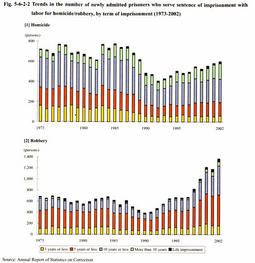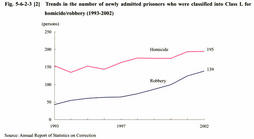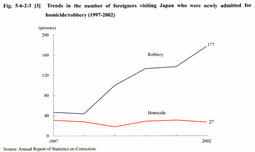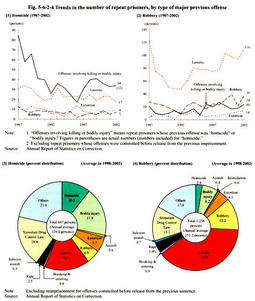| Previous Next Index Image Index Year Selection | |
|
|
1 Treatment in penal institutions (1) Overview Fig. 5-6-2-1 shows the trends in the number of newly admitted prisoners for homicide/robbery and the percentage of such prisoners in the total of newly admitted prisoners. The number of newly admitted prisoners for homicide had remained almost flat since 1973, but it decreased in 1988, and has been on a slightly upward trend since 1993. The percent distribution of such prisoners in the total of newly admitted prisoners has been flat or on a downward trend. For robbery, the number of newly admitted prisoners shifted from leveling-off to a decrease in 1985, and then turned to increase in 1991. The number has been on a stronger upward trend since 1997. The percent distribution of such prisoners also has shown an upward trend since 1999. Comparing between 1990 and 2002, the number of newly admitted prisoners increased 3.5-fold while the percent distribution increased by 2.9 points from 1.7% to 4.6%.
Fig. 5-6-2-2 shows the trends in the number of newly admitted prisoners for homicide/robbery, by term of imprisonment. The term of imprisonment has, by necessity, become longer corresponding to the harsher sentencing by the courts, which is considered to be a factor that has brought about the recent rapid increase in the total number of newly admitted prisoners and excess of offenders imprisoned in penal institutions (see Part 2, Chapter 4, Section 1 ). Fig. 5-6-2-1 Trends in the number and percentage of newly admitted prisoners who serve sentence of imprisonment with labor for homicide/robbery (1973-2002) Fig. 5-6-2-2 Trends in the number of newly admitted prisoners who serve sentence of imprisonment with labor for homicide/robbery, by term of imprisonment (1973-2002) (2) Increase in the number of first-time prisoners, long-term sentenced prisoners, and foreign prisoners Fig. 5-6-2-3 [1] shows the rate of repeat prisoners (persons who have previously been imprisoned to penal institutions once or more) among newly admitted prisoners for homicide/robbery. The rate of repeat prisoners among newly admitted prisoners has been on a declining trend for both homicide and robbery. Viewing actual numbers, the number of first-time prisoners has been on an increasing trend since 1993 for homicide and since 1991 for robbery. In addition, Fig. 5-6-2-3 [2] shows the trends in the number of newly admitted prisoners for homicide/robbery who were classified into Class L (inmates with a term of 8 years or more). For homicide, the number of such prisoners has slowly increased in the last 10 years while continuing to increase and decrease. The number increased from 154 in 1993 to 195 in 2002. As for robbery, the number has increased remarkably since 1998, and was 139 in 2002, 3.2 times that in 1993. Fig. 5-6-2-3 [3] shows the trends in the number of foreigners visiting Japan among newly admitted prisoners for homicide/robbery. The number for homicide has been flat but that for robbery has been increasing remarkably since 1999.
Fig. 5-6-2-3 [1] Trends in the rate of repeat prisoners among newly admitted prisoners for homicide/robbery (1973-2002) Fig. 5-6-2-3 [2] Trends in the number of newly admitted prisoners who were classified into Class L for homicide/robbery (1993-2002) Fig. 5-6-2-3 [3] Trends in the number of foreigners visiting Japan who were newly admitted for homicide/robbery (1997-2002) (3) Repeat prisoners and type of previous offense Fig. 5-6-2-4 [1] and [2] shows the trends in the number of repeat prisoners for homicide/robbery, by type of previous offence for which they served sentence (limited to offenses involving killing or bodily injury (homicide and bodily injury), robbery, larceny, and extortion). Fig. 5-6-2-4 [3] and [4] shows the percent distribution of repeat prisoners for homicide/robbery in the last 5 years, by type of previous offence.
For many prisoners newly admitted for homicide, their previous offenses are offenses involving killing or bodily injury, followed by larceny. Viewing the average percentage in 1998-2002, offenses involving killing or bodily injury accounted for 28.4% while property offenses for the purpose of taking or extorting money or articles, such as larceny, robbery, and extortion, had the almost same share, accounting for 27.2%. Stimulant Drug Control Law violation also had a relatively large share with 18.4%. As for prisoners newly admitted for homicide, it is not necessarily the case that they have served a previous sentence for an offense involving killing or bodily injury, and there is the same level of possibility that an offender who has served a sentence for larceny or Stimulant Drug Control Law violation will commit homicide. In contrast, larceny is the previous offense for the overwhelming majority of prisoners newly admitted for robbery. Viewing the average percentage in 1998-2002, larceny accounted for 38.5% while robbery accounted for 12.2%, and their total exceeded a half, at 54.9%. The percentage of offenses involving killing or bodily injury and that of Stimulant Drug Control Law violation were 8.6% and 13.1 % respectively, which are low in comparison to those for prisoners newly admitted for homicide. As for prisoners newly admitted for robbery, those who have previously served a sentence for property offenses, especially larceny and robbery, accounted for a high percentage (see Chapter 5, Section 2 for the fact that there have been considerable number of cases in which a habitual theft commits robbery or homicide on the occasion of robbery and that there is a type of offenders who shift from larceny to robbery). Fig. 5-6-2-4 Trends in the number of repeat prisoners, by type of major previous offense (4) Implementation of education in penal institutions from the perspective of victims Amidst recent social request for victim protection and support, a key issue has been the introduction of the perspectives of crime victims in implementing educational activities in penal institutions (see Part 2, Chapter 4, Section 3-3 ). Based on such circumstances, penal institutions have introduced the "guest speaker system" in which third parties with sufficient knowledge in victim protection and support are invited as lecturers to provide, guidance to facilitate inmates to reflect on their actions and arouse a sense of guilt in them. The system has been implemented in 34 institutions (as of July 2002) in total nationwide, including juvenile prisons, women's prisons, and prisons to imprison male adult offenders whose tendency to commit offenses has not proceeded. Such lectures have been implemented 383 times (targeting 11,481 persons) during the period from June 2001 to July 2002. By form of implementation, lecture was most frequently implemented as part of guidance depending on type of treatment (112 times, targeting 1,161 persons), followed by guidance on commencement of the execution of sentence (93 times, targeting 1,153 persons), guidance prior to release (44 times, targeting 350 persons), individual consultation (32 times, targeting 32 persons), and plenary lecture (24 times, targeting 7,585 persons). As of July 2002, 80 lecturers (specifically, volunteers in private victims associations, etc., researchers in victimology or other fields, psychiatrists and experts in clinical psychology, etc., legal professionals, persons involved in police activities, etc.) give speeches about the suffering of victims and bereaved family members of deceased victims in line with specific facts (Source: Correction Bureau, Ministry of Justice).
In addition, efforts have been made to improve guidance depending on the type of treatment with the aim of facilitating offenders to reflect on their offenses and cultivate a sense of atonement toward the victims, such as education to develop respect for life, education to cultivate atonement, and education on prevention of sexual offenses. |





